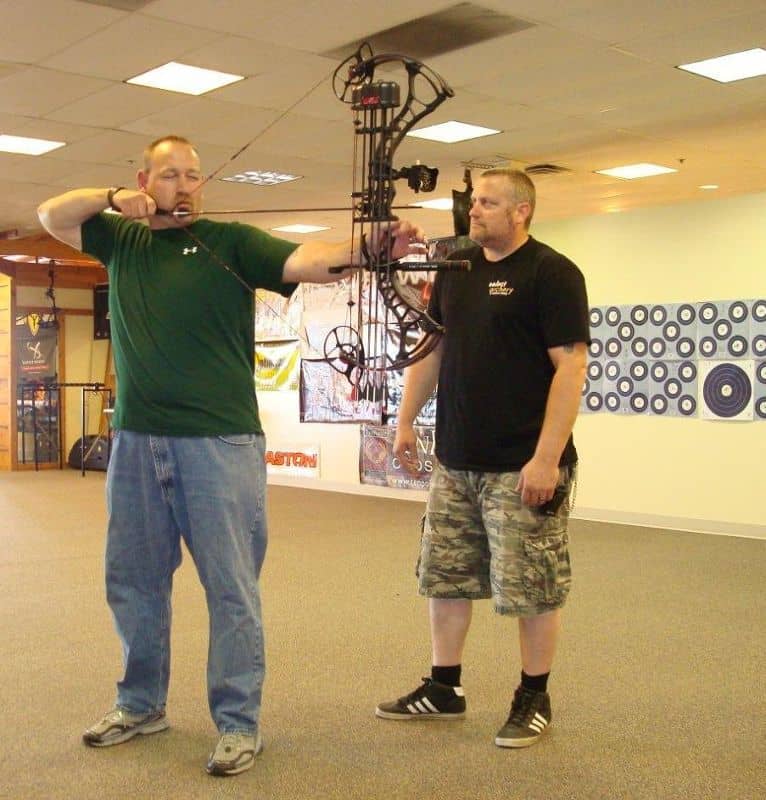Matt “Flatlander” Cheever of the BIG DEER Hunt Team is an expert 3-D archer and bowhunter from Illinois. Matt’s tips for selecting the best bow for you will have you shooting pretty:
Draw weight: Used to be you wouldn’t hear guys confess to shooting less than a 70-pound bow. Today, there are lots of women shooting 50-pound bows and killing deer out past 40 yards. If we put our macho pride aside we’ll realize that today’s bows at 60 pounds have more energy and speed than the 70- to 80-pounders of years ago.
Rule of thumb #1: is to be able to pull a bow back from the seated position while its poundage is maxed out, and then let it back down without causing a premature arrow release or going into convulsions. A 60-pound bow maxed out is way more efficient than a 70-pound bow backed off to 62.
Rule #2: You should be able to draw your bow while it’s pointed at the deer, without having to lift it or gyrate about. If you can’t pull a bow and then let down if needed without being detected by a big whitetail buck, then you have too much bow for your upper-body strength.
The smoothness of a bow has a lot to do with the valley, or point, where the let-off (usually 65%) comes into play; the sharper the angle on the cam, the harder it rolls over, and thus the more speed generated. You need to find that sweet spot between smooth draw for your strength, but also to keep adequate speed and energy for a nice flat arrow trajectory.
There is currently a speed craze in the bow market, which is fine and dandy, but speed ratings from the factory don’t translate into a hunting package. Not long ago at a 3D shoot we pulled out a chronograph to measure arrow speed. A few shooters boasted about buying bows that supposedly shot 330 feet per second, but after a half dozen of us shot and tested, we concluded that the slowest bow there shot 265 f.p.s. and the fastest one shot 290. The moral of the story is that by the time you get your sight, rest, quiver, stabilizer, etc. on the bow, you will not shoot the advertised speed rating. Get over it, it’s not that critical. My first deer with a recurve bow shot 160 f.p.s. and that deer is still just as dead.
For deer hunting, quietness of a bow is second only to draw weight. If a bow is loud and puts off bad vibrations it can and will spook game and cause deer to jump the string. All bows make some noise–some a slap, others more of a prolonged twang. These things can be quieted the aid of silencers and stabilizers, but it doesn’t hurt to start with an inherently quiet bow.
Draw length: For some reason, many people try to shoot a bow with a draw length that is too long for them. To get an idea of your draw length, stretch out your bow arm, make a fist, rest the fist against a wall and use a tape to measure from the wall to the corner of your mouth–28, 29 inches, etc. The best way to get your exact draw length is to go to a bow shop and have a pro measure you.
Bow length: The measurements of a bow are critical, and largely affected by personal preference. Any bow longer than 38 inches axle to axle gets cumbersome in a tree stand; any bow shorter than 32 inches allows for little error in shooting technique and follow through. I tend to shoot a longer bow, and if you’ll notice target shooters do the same. A longer bow is more forgiving; it helps to compensate for less-than-perfect shooting form, and when you shake a little when you aim at a buck. A shorter bow may be faster and have more stored energy, but having great shooting form and making precise moves when drawing, aiming and following through are more critical.
Brace height: The same can be said for brace height, or the measurement between the string and the back of the bow’s grip (when the bow is not drawn). Too short a brace height and a bow can be finicky and less forgiving to shoot; too long a brace height and you could give up too much speed and performance. I, and most of the hunters at BIG DEER, like to stay in the 6- to 7-inch range.
Price: You can get a great bow at the top of the money spectrum, and you can get a cheap one at the bottom. We at BIG DEER don’t recommend either. Get the best quality bow you can afford, and the one that fits you and feels right in your hands. Stick with a company that stands behind their product and is readily available for parts and service. In this ever growing and saturated market, there isn’t room for poor quality, so most brands make a nice line of bows. There is nothing wrong with a base model, or last year’s hold-over models either.
The best way to shop for a new bow is to shoot a half-dozen prospects. Forget about the brand names, the fancy camouflage finish, cost… If possible stand 10 yards from a wall target, close your eyes and just release an arrow; the shock in your hand, the strain in your back and the noise in your ear (or better, the lack of any noise) will tell you which bow is the winner is, and which one will help you kill more deer.

